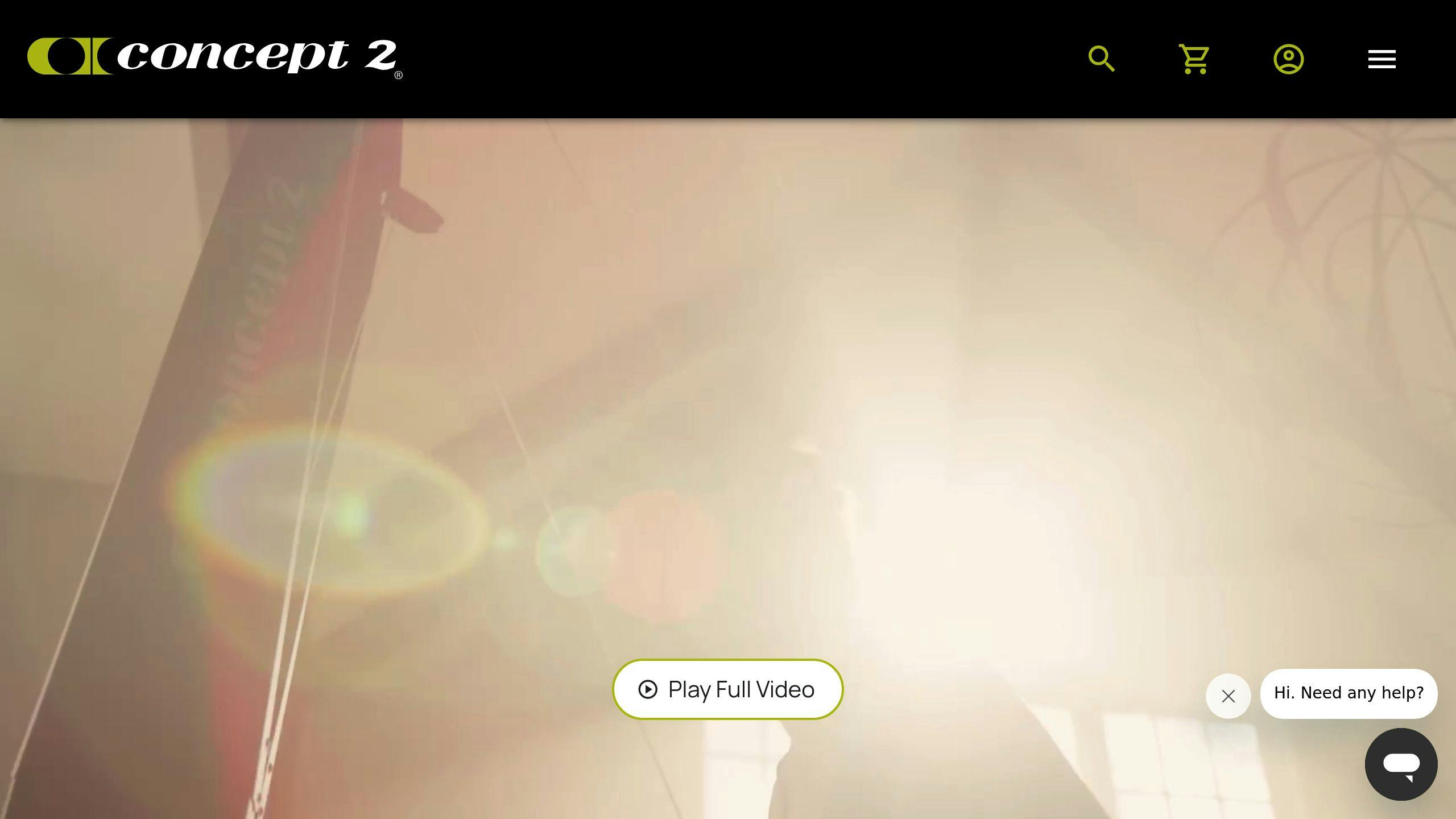Hyrox is a unique race combining running with 8 intense workout stations. To succeed, you need endurance, strength, and strategy. Here are 10 essential exercises to prepare for every challenge you'll face:
- Ski Erg: Builds upper body endurance and rhythm for the 1000m start.
- Sled Push: Strengthens legs and mental toughness on resistance-heavy surfaces.
- Sled Pull: Focuses on grip, back, and core strength for smooth, efficient pulls.
- Burpee Broad Jumps: A full-body test of power, stamina, and smooth movement.
- Rowing: Develops stamina and pacing for the 1000m rowing station.
- Farmers Carry: Boosts grip strength and total body control for carrying weights.
- Sandbag Lunges: Builds lower body stability and core strength for sandbag stations.
- Wall Balls: Enhances explosive power and endurance for high-rep throws.
- Interval Running: Prepares you for the 8 x 1km runs between stations.
- Functional Movements: Combines key patterns like squats, pulls, and core work to simulate race demands.
Quick Tips:
- Train with race-specific weights and distances.
- Use intervals to build endurance and simulate race conditions.
- Focus on form to avoid energy waste and injuries.
Related video from YouTube
1. Using the Ski Erg

The Ski Erg kicks off your Hyrox race - you'll need to crush 1000m before moving on. It's your first test, so don't blow all your energy here. While your arms and shoulders do the heavy lifting, your core and legs play key supporting roles.
Think of it like starting a long road trip - you don't floor it right out of your driveway. You need a pace that'll keep you moving strong through all eight stations.
Here's how to nail your technique:
- Stand tall, lean slightly forward
- Keep hands shoulder-width apart
- Pull down with your arms, feel those lats work
- Brace your core like you're about to take a punch
- Find your rhythm and stick to it
Smart Training Approach Start with shorter bursts - 250m at the pace you plan to race. Once that feels good, bump it up to 500m sets with 60-second breathers. Pay extra attention to your form when you're tired - that's when things tend to fall apart.
Remember: The Ski Erg is just the beginning. Save some juice for the Sled Push coming up next - that's where your legs will need to do the talking.
Pro Tip: Count your strokes or set a steady beat in your head. A consistent rhythm helps you manage your energy better than going all-out from the start.
2. Mastering the Sled Push
The sled push comes right after the Ski Erg, and it's no walk in the park. This exercise puts your lower body and mental toughness to the test. What makes it extra spicy? You're pushing on Hyrox's Roxzone flooring, which adds more resistance than your typical gym floor.
Here's what good form looks like: Get low (but not too low), push with your legs while keeping your core tight, and lock those arms straight. Think of yourself as a human locomotive - steady, powerful, and always moving forward. And don't forget to breathe - many athletes hold their breath without realizing it.
Want to crush this station on race day? Load up your training sled with extra weight. It's like training with a weighted vest - when race day comes, the standard weight feels lighter. Mix in some running between pushes to get used to that race-day feeling. And here's something many people miss: Train on different surfaces. The Roxzone floor is its own beast, so you need to be ready for anything. Oh, and wear shoes with good grip - you don't want to be sliding around like a penguin on ice.
Here's a pro move that'll save your energy: Take a quick 5-10 second breather halfway through each lane. It's just enough time to check your form, brace your core, and catch your breath without losing momentum.
After you're done pushing that sled, get ready - the sled pull is up next, and it's got its own set of challenges waiting for you.
3. Perfecting the Sled Pull
The sled pull works your entire body, with extra focus on your glutes, back, biceps, and core. It's the natural next step after the sled push, and getting it right means mastering both your grip and technique.
Here's what makes a great sled pull: Plant yourself in a strong athletic stance with your core locked in. Push through your heels while getting your glutes and back muscles to do the work. The key is to pull smoothly and consistently - jerky movements just waste your energy. Watch your grip - it gets trickier as you get tired.
Want to build race-day confidence? Train with weights that are a bit heavier than what you'll face in competition. Break up your pulls into 10-meter chunks. This lets you reset your form and gives your hands quick breaks between pulls.
Pro tip: Mix sled pulls into your HIIT workouts. Try this: Pull for 30 seconds, rest for 30 seconds, and do this 4-6 times. This workout matches the intensity you'll hit during the race while building your staying power. Stick with it, and you'll see your pulling strength shoot up.
Next up: Those heart-pumping burpee broad jumps.
4. Practicing Burpee Broad Jumps
Burpee broad jumps pack a serious punch in Hyrox competitions. They'll test every muscle in your body while pushing your power and stamina to the limit. Think of it as a full-body symphony where every movement needs to flow perfectly into the next.
Here's how to nail the technique: Stand tall, drop down to a squat position, shoot your legs back to plank, knock out a clean push-up, pop back to squat, then EXPLODE forward into a jump. Land light on your feet - think ninja, not elephant. Your breathing matters too: blow out during the push-up, breathe in as you jump. The key to speed? Smooth transitions between moves.
Want to level up your game? Keep your core tight - it's your power center and your shield against back pain. When you're gasping for air (and you will be), don't let your push-ups get sloppy. Bad form will drain your energy faster than a phone with 100 apps running.
Mix these into your workouts with a simple but brutal format: 30 seconds all-out work, 30 seconds catch-your-breath rest. Do this 4-6 times and you'll know what Hyrox feels like.
Pro tip for race day: Break up your reps into chunks you can handle. It's better to keep moving steadily than to blast through the first few reps and hit the wall. Think tortoise, not hare - except this tortoise can do burpees.
Time to hit the rowing machine next - your endurance journey's just getting started.
5. Building Endurance with Rowing
Want to crush your Hyrox race? Let's talk about rowing - it's not just pulling a handle back and forth. This full-body workout builds the stamina you'll need for both the running segments and workout stations.
Think of rowing as a dance where your whole body moves in sync. Your legs push, your core swings, and your arms pull - all working together. Here's the simple breakdown: push through your heels, swing those hips back, then pull with your arms. Going forward? Just reverse it: arms out, body swing, then slide up.
Start position matters: Begin with straight legs, arms reaching forward, and your core tight. Get this right, and you'll row better and longer during that 1000-meter challenge.
Here's how to train smart: Don't try to tackle 1000 meters all at once. Start by doing 250-meter sprints at your target race pace, rest for 60 seconds, then go again. Once that feels manageable, bump it up to 500-meter chunks. The key? Find a pace you can hold steady when race day comes.
"The rowing station in Hyrox demands sustained effort and endurance across 1000 meters. Success comes from mastering both technique and pacing strategy."
Nail your form: Keep that back straight, shoulders loose, and grip solid (but don't strangle the handle). Aim for 24-28 strokes per minute - this pace helps build endurance.
Your breathing makes a big difference too. Breathe in as you come forward, out as you drive back. This pattern keeps you in rhythm and helps fight off fatigue - super important when you're tackling that 1000-meter row.
Now that you've got your rowing down, let's get those hands ready for the farmers carry.
sbb-itb-8bcd5e0
6. Improving Grip Strength with Farmers Carry
Want to crush the Hyrox stations? Here's something many athletes overlook: grip strength. When your grip fails, everything else follows - and that's where the farmers carry comes in.
Let's break it down: Stand tall, weights in hand, shoulders down and back, core tight. Think of your body as one solid piece - everything needs to work together.
Start small, think big: Pick weights you can actually control. Your arms? They should hang naturally - no wild swinging allowed. Take baby steps at first. It might feel slow, but trust me: control beats speed every time.
Here's your 6-week game plan to level up your farmers carry:
| Week | Weight | Distance | Sets | Rest |
|---|---|---|---|---|
| 1-2 | 50% race weight | 20m | 4 | 90 sec |
| 3-4 | 75% race weight | 30m | 3 | 60 sec |
| 5-6 | Race weight | 40m | 2 | 45 sec |
Lock that core: Think of your core as your power center. It's not just about holding weights - it's about moving with purpose. Mix up your training with dumbbells, kettlebells, or whatever heavy stuff you've got handy.
"The farmers carry station in Hyrox demands not just grip strength, but total body control. Success comes from mastering the balance between tension and movement while maintaining proper form throughout the distance."
Here's the deal: nail your form, practice regularly, and watch your endurance skyrocket. Your grip will thank you on race day.
Ready to step it up? Let's talk about sandbag lunges - your next power move in the Hyrox arsenal.
7. Strengthening with Sandbag Lunges
Sandbag lunges are a key exercise for Hyrox success. They mirror the load-bearing challenges you'll face during the race and help build the muscle memory you'll need for the sandbag carry stations.
Here's how to nail your form: Keep your back straight and core tight - imagine someone's about to punch you in the stomach. Pull your shoulders back and down to create a solid base for the sandbag. When you step forward, your front knee should line up with your ankle (NOT past your toes). Let your back knee drop close to the ground without hitting it, and your back heel will naturally lift as you move.
Power tip: Think of your core as your engine room. The better you brace it, the more power flows through each step. Smooth, steady movements beat rushed ones every time.
Here's a step-by-step plan to build your sandbag lunge strength:
| Training Phase | Weight | Distance | Sets x Reps | Rest |
|---|---|---|---|---|
| Foundation | 50% race weight | 15m | 4 x 10 | 2 min |
| Build-up | 75% race weight | 20m | 3 x 15 | 90 sec |
| Race-ready | Full race weight | 25m | 2 x 20 | 60 sec |
Start light - about half your race weight - and focus on form before adding more weight. For Hyrox, you'll use either 10kg, 20kg, or 30kg based on your category. Mix up your training with forward and reverse lunges. Add some planks and Russian twists to boost your core strength - you'll need it when carrying that sandbag.
"The sandbag lunge station demands not just strength, but perfect balance and core stability. Success comes from training with progressive overload while maintaining impeccable form throughout the movement."
Now that we've got your lower body sorted, let's look at how wall balls can boost your explosive power for race day.
8. Boosting Power with Wall Balls
Wall balls might look simple, but they're one of the toughest parts of Hyrox. Women throw a 6kg ball to 9 feet, while men handle a 9kg ball to 10 feet. Getting this station right comes down to two things: perfect form and smart pacing.
Let's nail the technique first. Grab the ball from the bottom (not the sides), and keep those elbows tucked in close. Your core should stay tight throughout - just like you learned with those sandbag lunges. Think of it as one smooth motion: squat down with the ball at your chest, then explode through your legs and hips to send that ball flying up.
Here's how to build up your wall ball game:
| Training Phase | Sets x Reps | Target Height | Rest Period | Focus Area |
|---|---|---|---|---|
| Foundation | 4 x 15 | Standard height | 2 min | Form and consistency |
| Build-up | 3 x 20 | Standard height + 1ft | 90 sec | Power development |
| Race-ready | 2 x 30 | Competition height | 60 sec | Endurance and speed |
Want to know the real game-changer? It's the EMOM (Every Minute on the Minute) method. Here's how it works: If you're aiming to finish the station in 4 minutes, you'll need to hit 25 reps each minute. Practice this exact tempo in training - it'll become your race-day rhythm.
Pro tip: When you start feeling the burn, drop your reps by 3-5. Better to keep moving smoothly than crash and burn.
"The wall ball station is where many athletes falter due to poor pacing. Success comes from knowing your sustainable rep range and sticking to it, regardless of what others around you are doing."
Mix in some planks and Russian twists to build a rock-solid core - you'll thank yourself later in the race. Once you've got your wall ball power dialed in, we'll move on to cranking up your running speed with intervals.
9. Increasing Speed with Interval Running
After mastering wall balls, let's tackle the running parts of Hyrox. With 8 x 1km runs between stations, your running strategy can make or break your race. Here's the thing: Hyrox running isn't just about being fast - it's about keeping your pace while you're tired from the workout stations.
Your training needs to match what you want to achieve on race day. Forget long, boring runs. Instead, focus on short, intense bursts. Here's what works for top Hyrox athletes:
| Interval Type | Work Period | Recovery | Total Rounds | Training Focus |
|---|---|---|---|---|
| Speed Bursts | 400m at 85% effort | 200m jog | 6-8 | Race pace development |
| Station Simulation | 1km at race pace | 3-min active recovery | 4-5 | Race endurance |
| Power Intervals | 200m sprint | 90-sec walk | 10 | Quick recovery ability |
Want to hit a sub-60 minute 1km split? Then you need to nail that pace in training. Don't just stand still during recovery - keep moving with a light jog or brisk walk. This keeps your blood flowing and stops your muscles from getting stiff.
Mix it up: Combine your runs with strength work to match real race conditions. Try this: 15 wall balls, followed by a 1km run, then 10 sled pushes. This gets your body ready for what you'll face in competition.
"The most effective Hyrox training combines interval running with strength work. This teaches your body to maintain running form even when fatigue sets in from the functional fitness stations."
Smart Training Tip: Watch your heart rate during recovery periods - it should drop to 65-70% of your max before you start the next round. This builds your stamina without wearing you out.
Now that you've got your running intervals sorted, we'll look at how to bring everything together with functional movement training.
10. Training Functional Movements
Let's talk about functional movements - the building blocks that make or break your race day performance. After you've built up your endurance and speed, it's time to put it all together.
Here's the deal: Master your form first, then dial up the intensity. Good form keeps you injury-free and helps you move better during the race.
These movements aren't just random exercises - they're exactly what you'll do on race day. Here's what the best Hyrox athletes focus on:
| Movement Pattern | Exercise Examples | Training Focus |
|---|---|---|
| Push/Pull | Push-ups, Pull-ups | Upper body strength and endurance |
| Hip Hinge | Deadlifts, Kettlebell swings | Posterior chain power |
| Squat/Lunge | Front squats, Walking lunges | Lower body stability |
| Core/Rotation | Planks, Russian twists | Core strength and balance |
Don't train these moves one by one - mix them up in high-intensity circuits that feel like the real race. Here's a circuit that'll get you race-ready:
- 10 deadlifts
- 20m farmer's walks
- 15 push-ups
- 400m run
Do this 3-4 times with minimal rest. Trust me, you'll feel the burn.
"Effective Hyrox training requires a comprehensive approach that combines structured periodization with functional strength and conditioning. The athletes who perform best are those who master the basics before progressing to advanced variations."
Break your training into three phases: base (nail those movement patterns), build (mix moves together), and peak (simulate race conditions). Keep your core work consistent - it's the backbone of every move you'll make during the race. Remember those core techniques from the wall balls and sandbag lunges sections? They'll come in handy here.
Mix and match movements while keeping your form tight. This way, when race day comes, you'll be ready for whatever each station throws at you.
Conclusion
Want to crush your next Hyrox race? Let's talk about putting all these exercises together.
Here's the thing about Hyrox: you can't just wing it. The format hits you with 8 one-kilometer runs plus 8 workout stations - that's no joke. You need a game plan that builds both your engine (cardio) and your power (strength).
The ten exercises we covered? They're your building blocks. But it's HOW you use them that makes the difference. Think of it like building a house - you need the right materials AND the right blueprint.
What makes a Hyrox athlete stand out? Three things:
- They build serious cardio capacity
- They develop functional strength
- They train their mind to push through tough spots
But don't fall into the "more is better" trap. Smart training beats hard training every time. Focus on getting these movements right, and give your body the rest it needs between sessions. Each workout should have a purpose - random sweating won't cut it.
Ready to step up your game? Start adding these exercises to your weekly training. Keep a log of your workouts and watch those numbers improve. Stick to your plan, and when race day comes, you'll be ready to bring your A-game.



